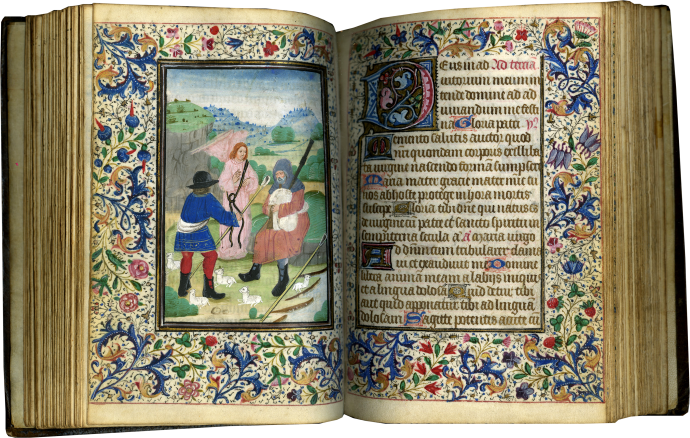


Book of Hours (use of Rome)
, c. 1460-1470


Book of Hours (use of Rome)
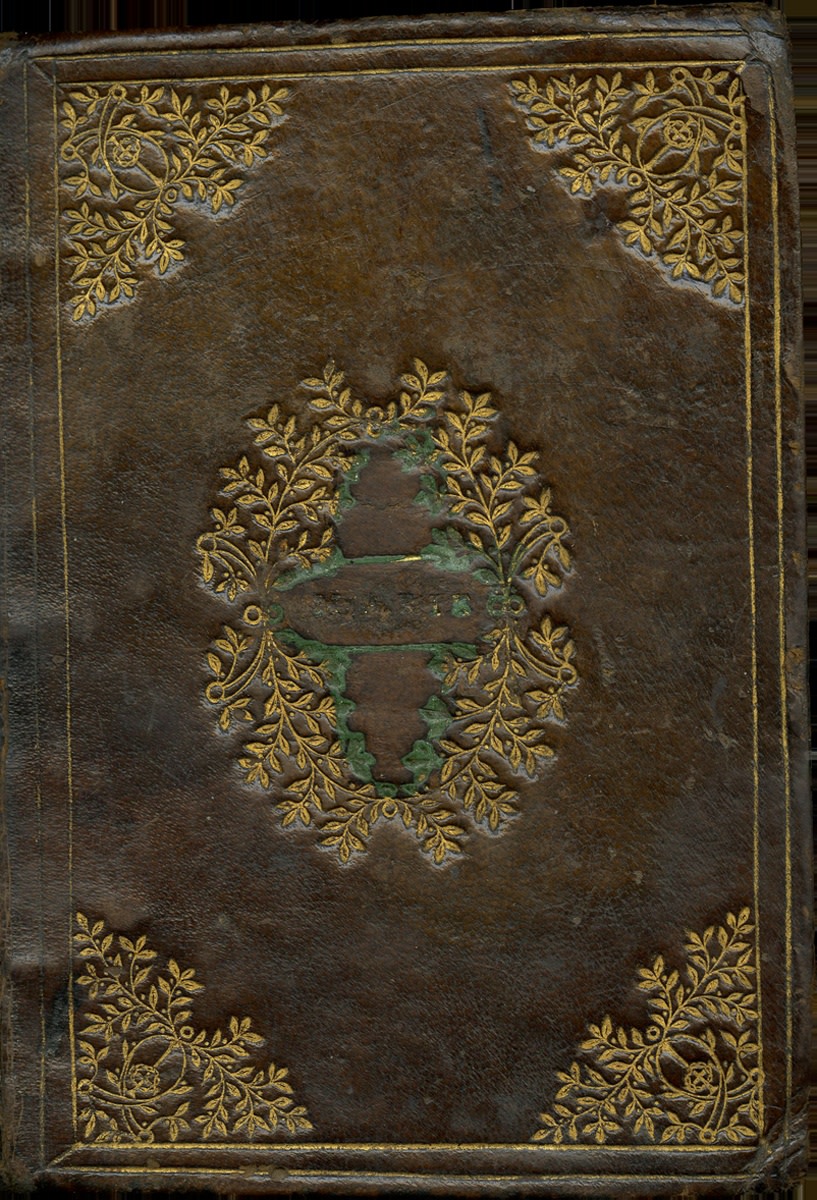

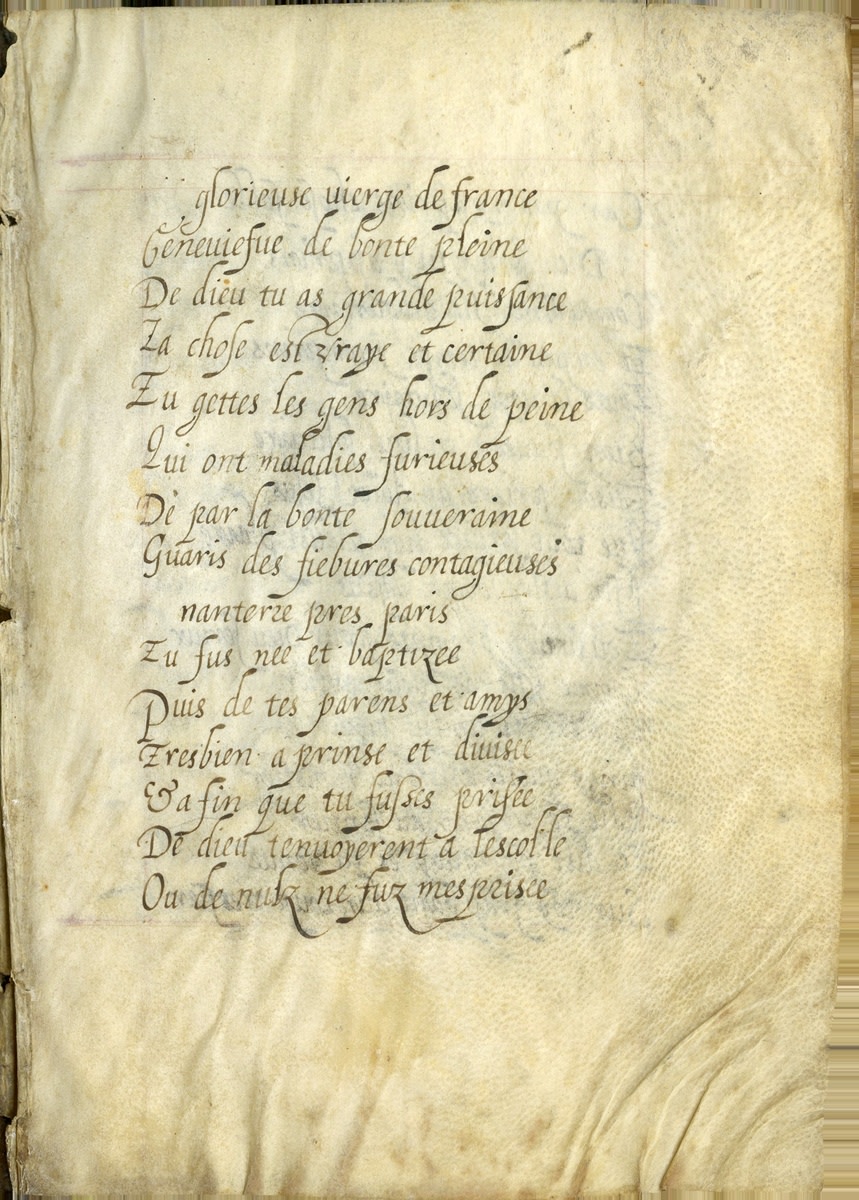








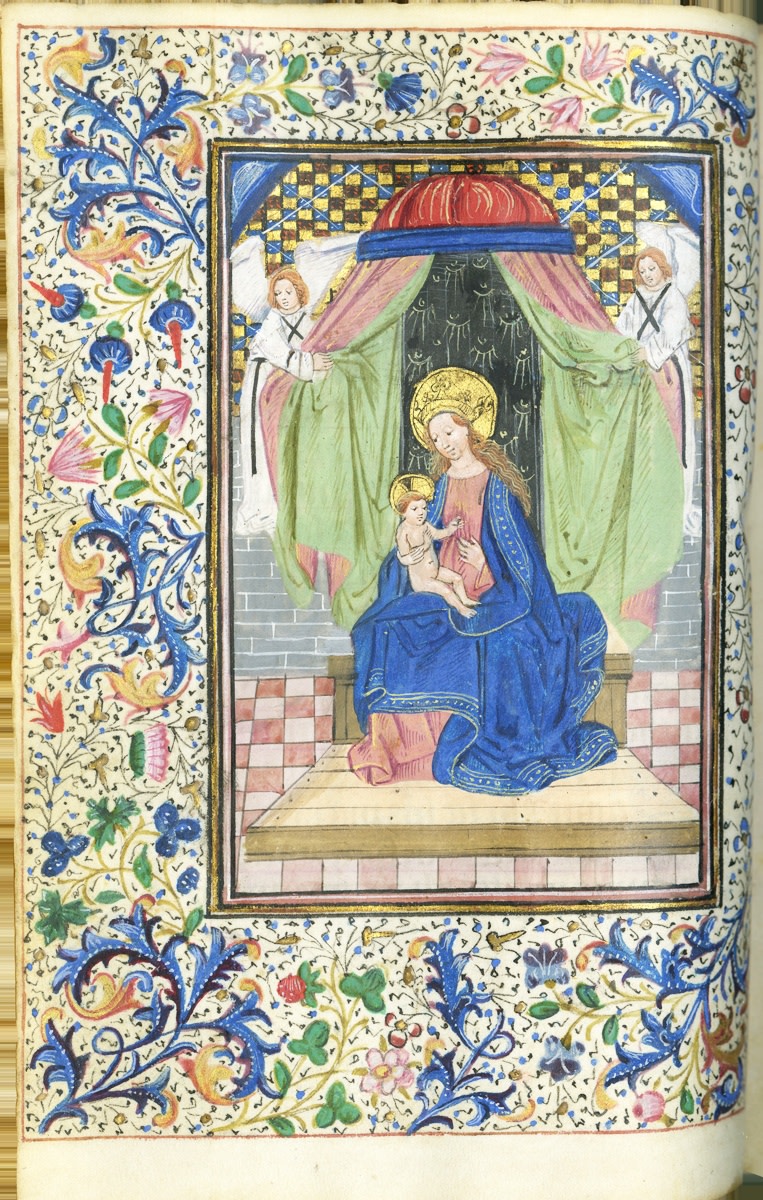



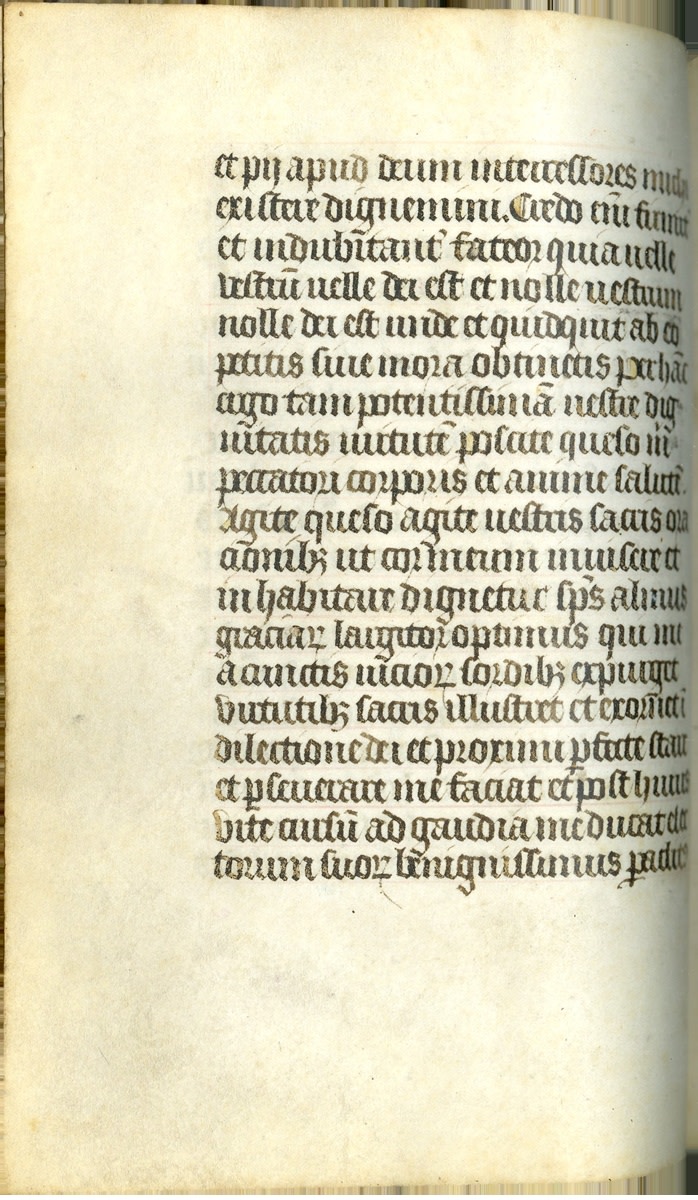
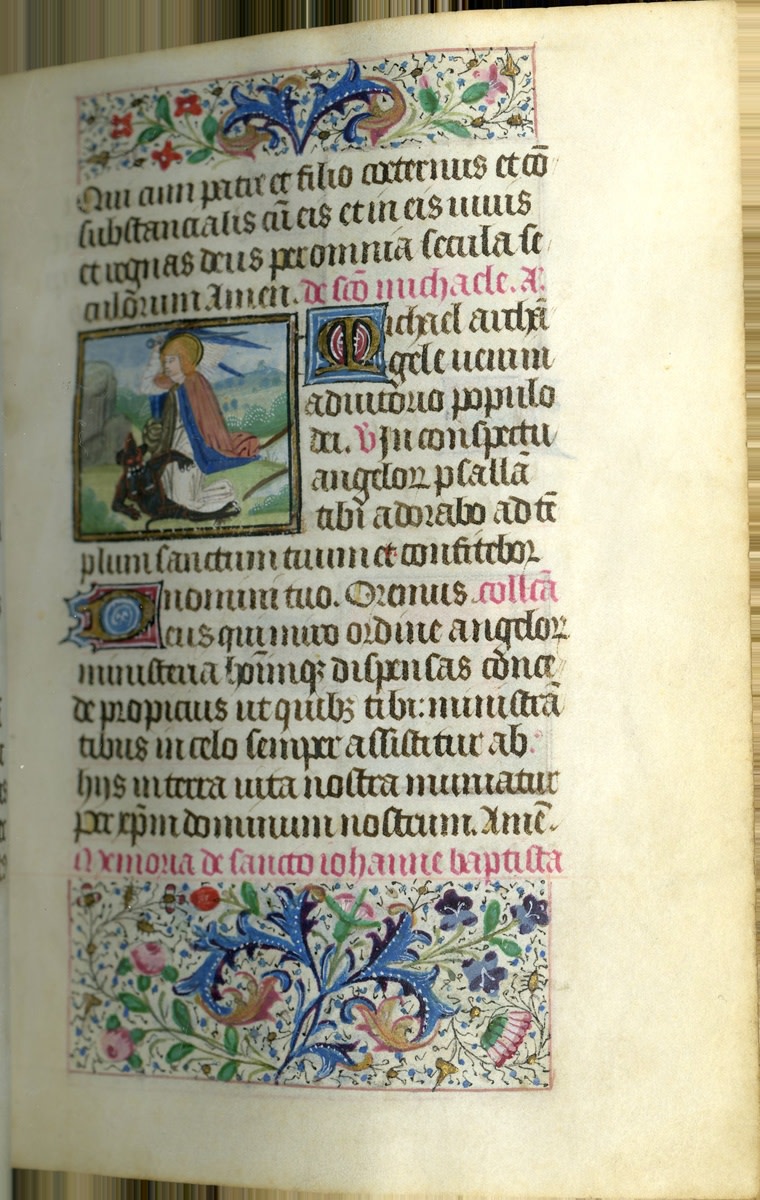



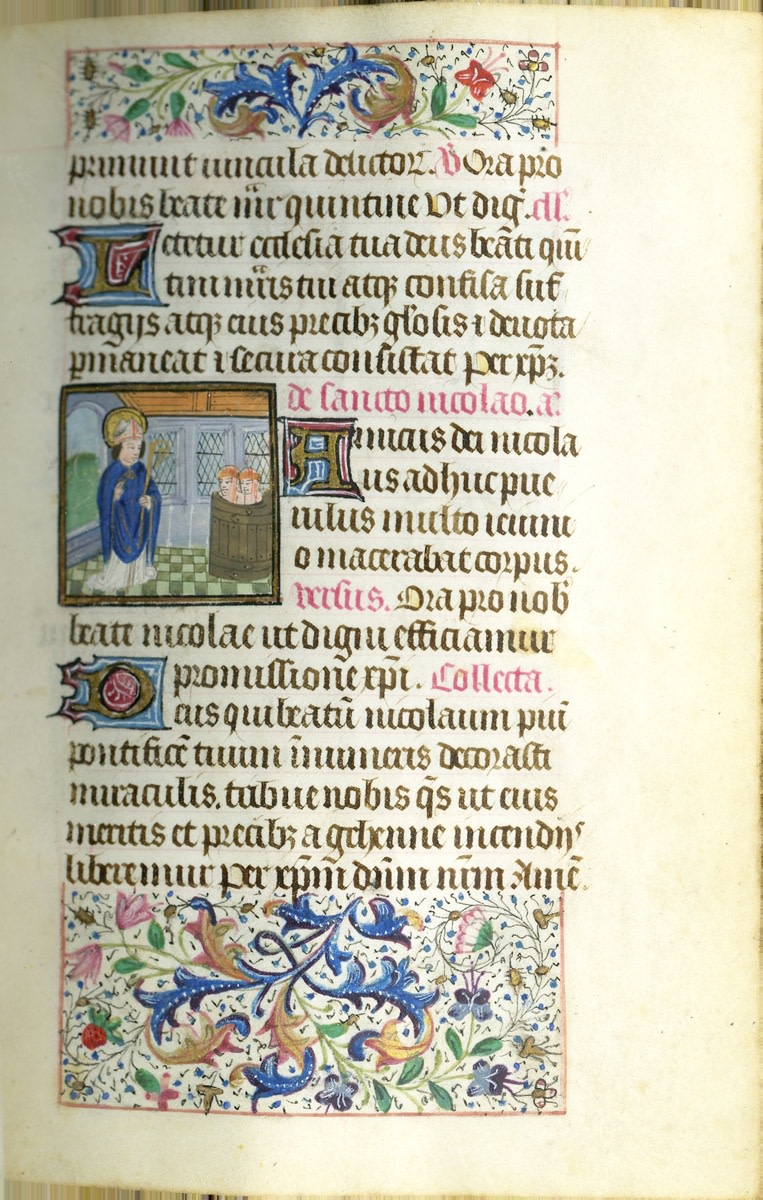

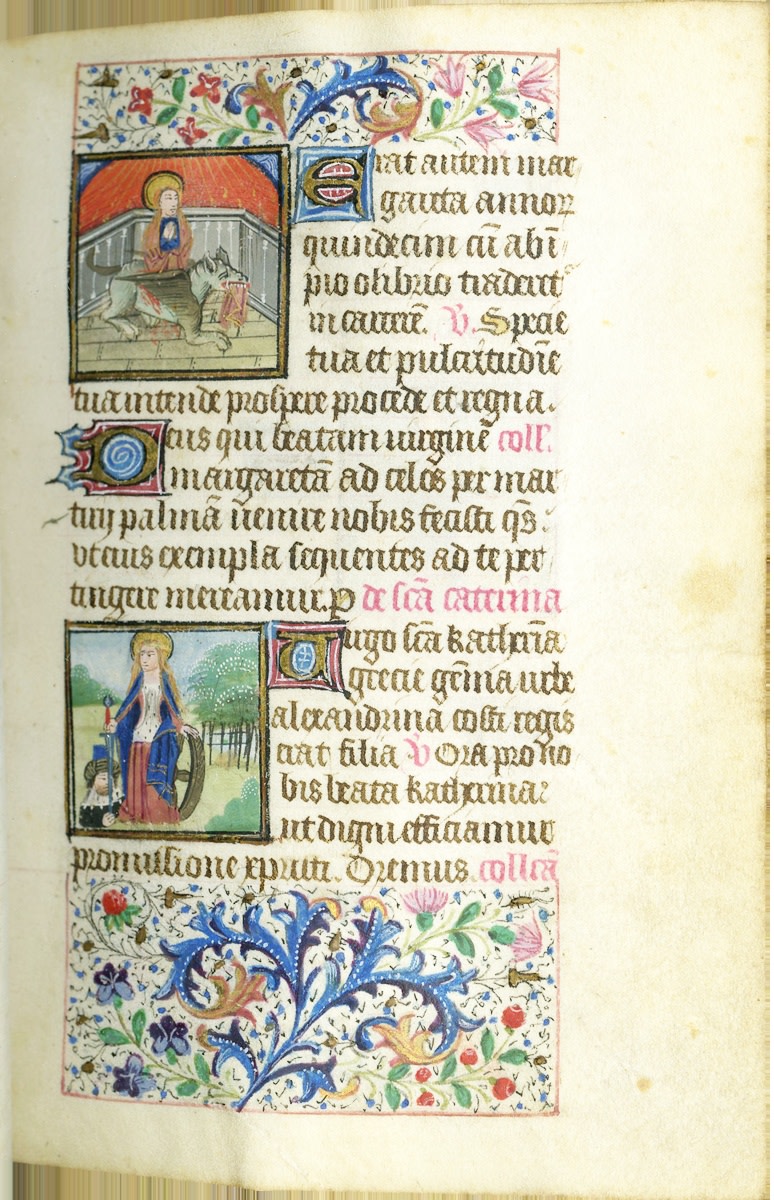

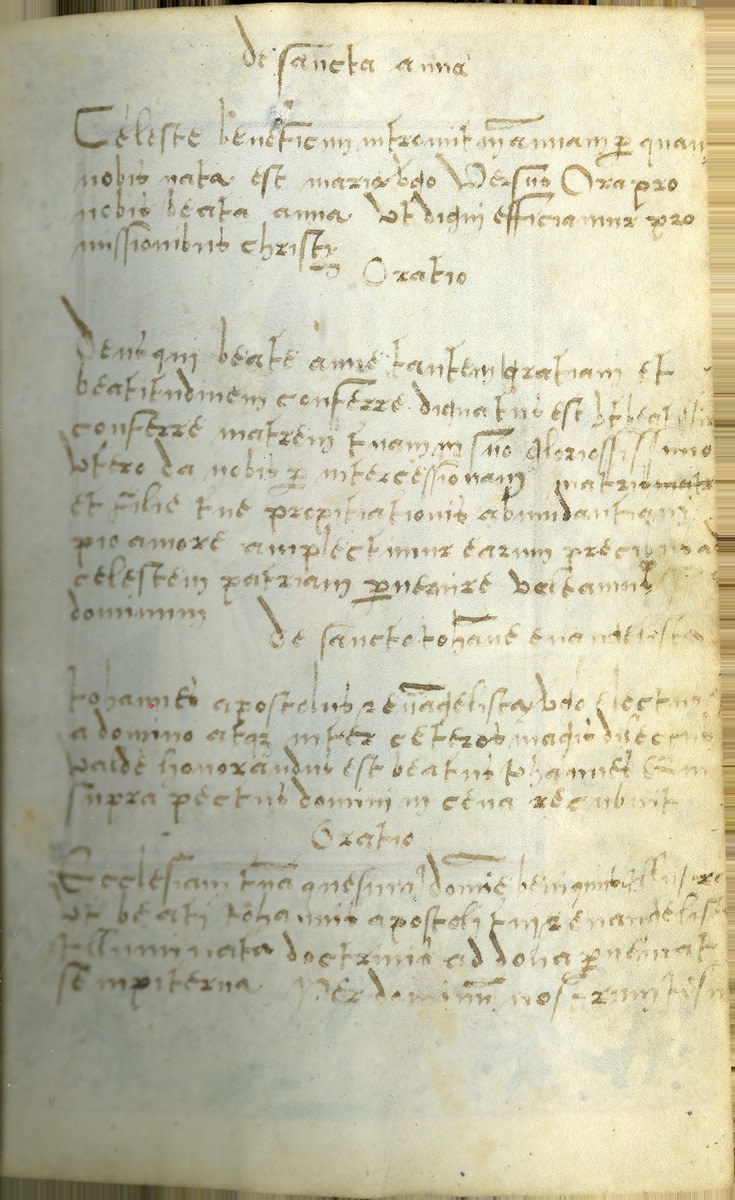

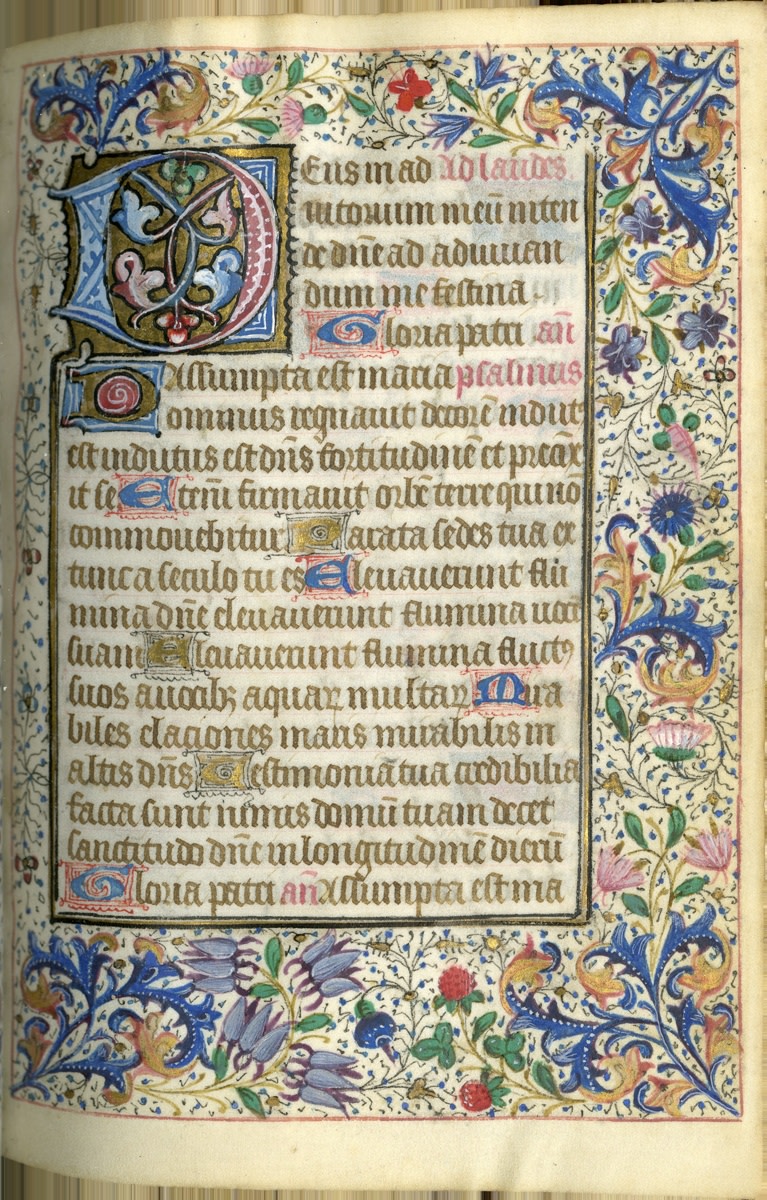



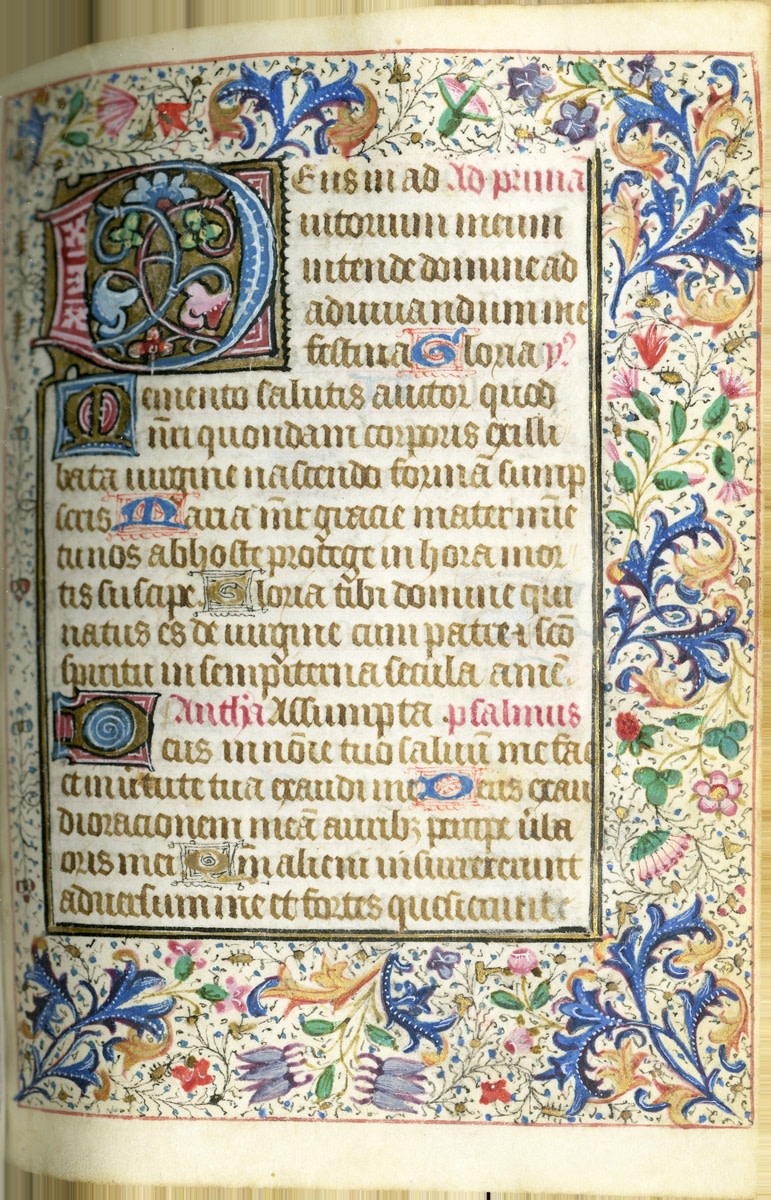


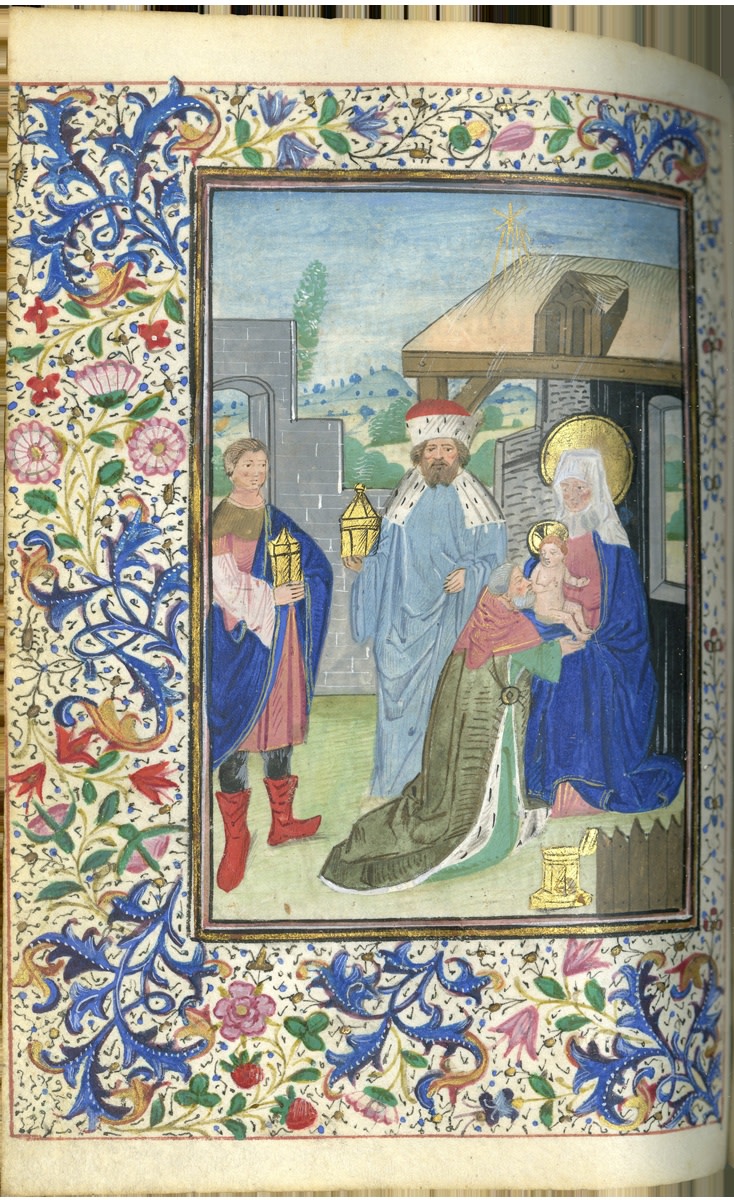


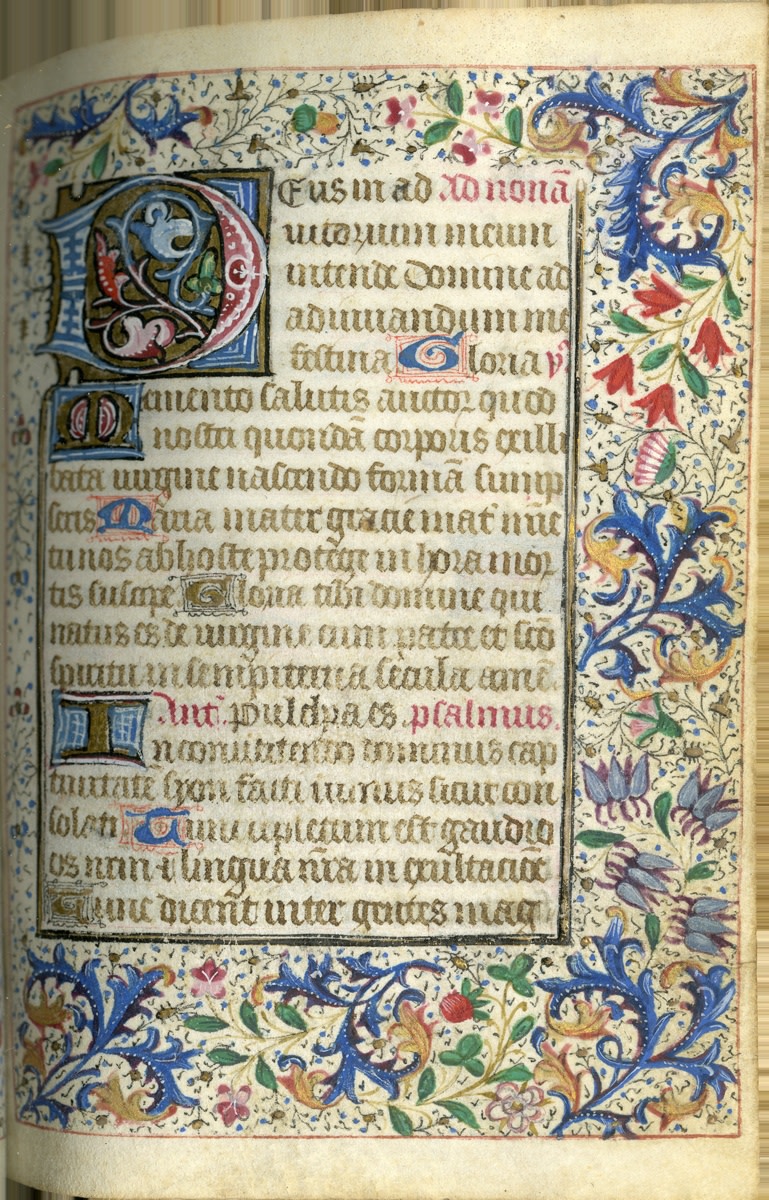
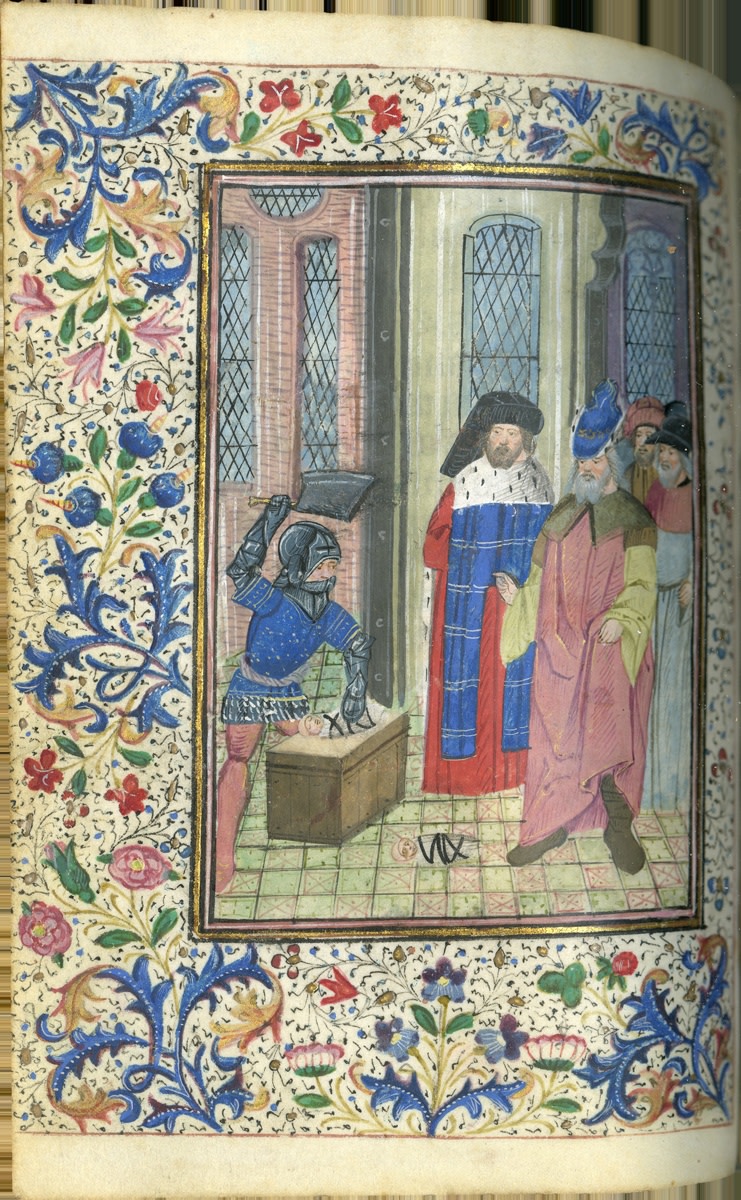





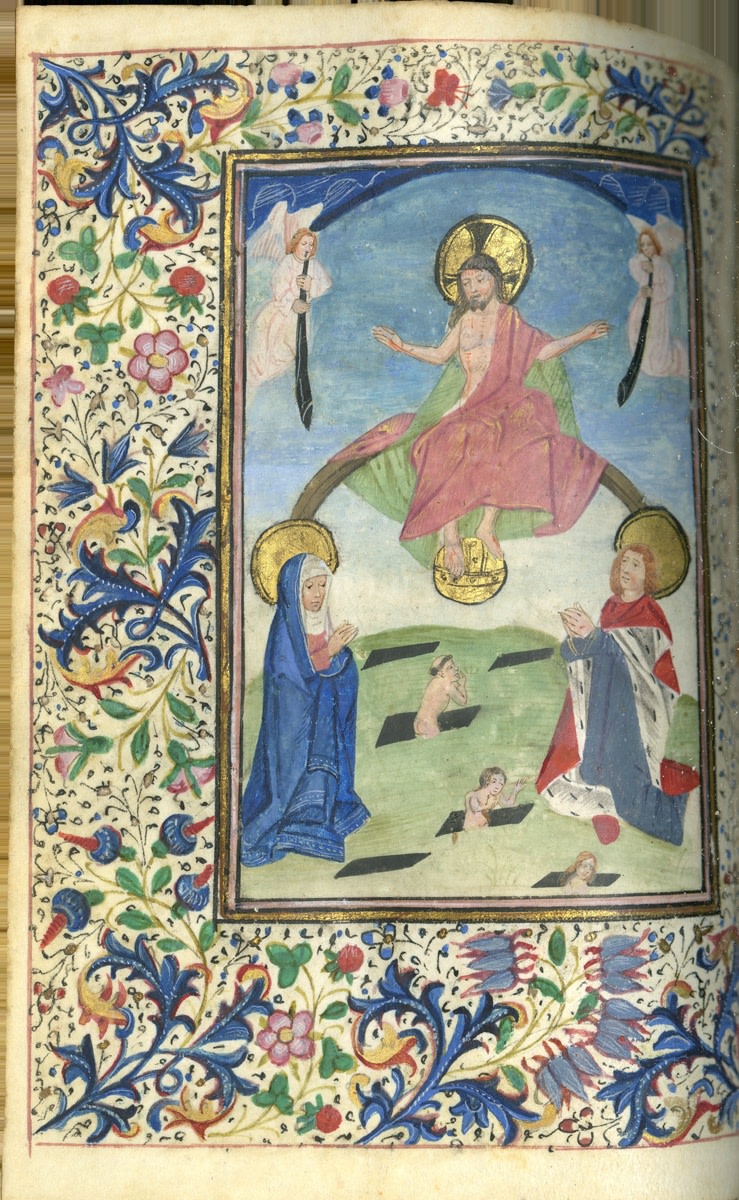





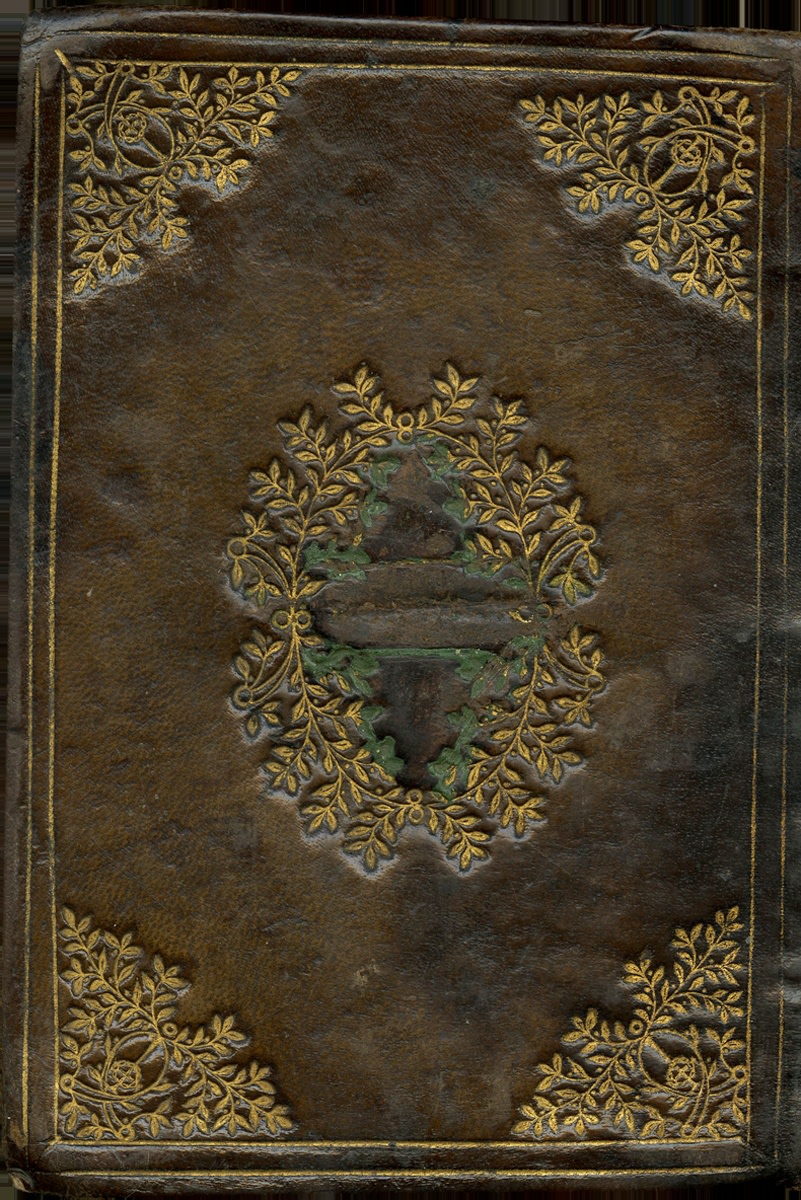
Description
Substantial manuscript in good condition with many large and small miniatures
This Book of Hours painted in the style of the Masters of the Beady Eyes is distinguished by its unusual and enigmatic details. Especially inventive is the angel who has descended from heaven to announce the birth of Christ to the shepherds. The artist is eager to represent architectural and structural details (nails, boards, fittings, varied stones and surfaces, apertures), which sometimes lead to curious spatial arrangements and juxtapositions. An added interest is provided by the numerous prayers and motets transcribed on the blank pages in the sixteenth and seventeenth centuries.
iii + 118 + v, folios on parchment, modern foliation in pencil, 1-118, complete (collation i-xvii6xviii10 xix6), ruled in red ink (justification 112 x 75 mm), written in brown ink in textualis (formata) bookhand on 19 lines, 1-line initials alternating in gold or blue with pen-flourishing in black or red respectively, line-fillers alternating in blue and gold in the litanies, 2- 3-line champ initials, fourteen 6-line blue or dark pink white-patterned initials with foliage or flower infill in blue, pink and green, on gold grounds, one historiated initial (5-lines), eleven small miniatures (6-lines), fourteen full-page miniatures, 40 pages with margins decorated with acanthus, flowers, fruit, a magpie and gold-leaf spraywork (upper and lower margins on the twelve pages with small miniatures and with the historiated initial, 28 full borders in the margins facing and matching those of the full-page miniatures at major text divisions), a few small stains, but in overall excellent condition. Bound in the nineteenth century in dark brown calf gold-tooled with laurel wreaths in the corners enclosing a crucifix entwined with a crown of thorns, and in the center surrounding the words in gilt (mostly rubbed out) MARIE (front board) and ROSARIE (back board), the laurel center piece partly tooled in silver (now oxidized), spine gold-tooled with a small Crucifixion and floral motifs, gauffered edges; the spine is worn in corners and the hinges are fragile. Dimensions 179 x 124 mm.
Provenance
1. The painting style, derivative of the Masters of the Beady Eyes, situates the production of this book in Ghent or Bruges around 1460-70. In addition to the miniature style, the margins of the manuscript incorporate trefoil blossoms with red or blue tips that are typical of Bruges manuscripts.
2. The manuscript was destined for use in the francophone region of the Southern Netherlands extending to the Northern France, as is demonstrated, firstly, by the inclusion of a suffrage to St. Quentin, venerated especially in the Northern France. Narrowing down the localization, the manuscript was probably made for an individual from Burgundy stationed in the Southern Netherlands, possibly in Bruges. This is suggested especially by the importance given to St. Benignus of Dijon, with three different feasts of the saint included in the calendar. It was probably this first owner of the book who added Claudius of Besançon, and a number of saints venerated in the Northern France and the Southern Netherlands to the calendar, as well as an indulgence prayer with a rubric in French at the end of the book (f. 118v).
3. Prayers in French and motets in Latin transcribed in the sixteenth century to the blank pages, by hand A on ff. 7, 32 and 71, and hand B on f. 92.
4. In the seventeenth century F. Legrand transcribed prayers to St. Genevieve and God in French on the front and end flyleaves and the back inner board, where he signed “F. Legrand 1669.” The name Legrand is common in Burgundy in the seventeenth century. One seventeenth-century member of the family was François Legrand, son of Jean Legrand. François (d. 1716) was premier huissier and, in 1690 named conseiller du Roi. He may have been the owner of this book and transcribed these prayers as a young man in 1669.
5. Private European Collection.
Tex
ff. i-iii verso (front flyleaves), a seventeenth-century addition: a prayer in French to St. Genevieve, incipit, “Glorieuse vierge de France / Geneviefve de bonté pleine / De Dieu tu as grande puissance / La chose est vraye et certaine…”;
This biographical prayer of twelve 8-line stanzas, with the rhyming scheme ababbcbc, was composed in the second half of the sixteenth century and was widely popular (Rézeau, 1983, p. 232, n. 1). This prayer and the one at the end of the book are both transcribed by the same hand and signed “F. Legrand 1669.”
ff. 1-6v, Calendar, with the local saints: Aldegonde of Maubeuge (30 Jan), Amand of Maastricht (6 Feb), Quirin of Neuss, whose hand relic is kept in the church of Houtaing in Hainaut (30 Avr), Lambert of Maastricht (16 Sep), Walburga, abbess at Heidenheim and patroness of Oudenarde, Veurne and Antwerp (12 Oct, the feast day of the translation of her relics to Eichstätt).
In a contemporary hand, the following saints have been added to the calendar: Claudius of Besançon (6 Jun), Medardus of Noyon (8 Jun), Philibert of Jumièges (20 Aug), Guy of Anderlecht (12 Sept), as well as the “relevatio,” the feast, and the translation of Benignus of Dijon (19 Oct, 1 Nov, and 24 Nov).
f. 7, a sixteenth-century addition: incipit, “Dulcis amica dei, rosa vernans, stella decora, tu memor esto mei dum mortis venerit hora…” [fifteenth-century motet];
ff. 7v-12, Short Hours of the Cross;
ff. 12v-16, Short Hours of the Holy Spirit;
ff. 16v-23v, Mass of the Virgin, Incipit missa beate Marie virgini, followed by the Gospel Sequences;
f. 24-26, Obsecro te, masculine forms, and including “N.” for inserting the name (“Et michi famulo tuo N. impetres”);
ff. 26v-27v, O intemerata;
ff. 28-31v, Suffrages of the saints: Michael, John the Baptist, Peter and Paul, Lawrence, George, Quentin, Nicolas, Marie Magdalene, Margaret, Catherine, and Barbara;
f. 32, a sixteenth-century addition: prayers to St. Anne and St. John the Evangelist; the title “de sancta anna,” is followed by the prayer, “Celeste beneficium introivit in annam, per quam nobis nata est maria virgo,” which is also the beginning of a motet composed by Jean Mouton in 1514, followed by prayers to St. Anne (incipit, “Versus [Versicle] Ora pro nobis beata anna, [Response] Ut digni efficiamur promissionibus christi Oratio Deus qui beata anna…”), before moving onto prayers to St. John the Evangelist;
ff. 32v-70v, Hours of the Virgin, use of Rome, Incipiunt hore beate Marie Virginis secundum consuetudinem romane, ff. 32v-43, Matins; ff. 43v-50, Lauds; ff. 50v-53, Prime; ff. 53v-56, Terce; ff. 56v-59, Sexte; ff. 59v-62, None; ff. 62v-67, Vespers; ff. 67v-70v, Compline;
f. 71, a prayer to the Virgin which was thought to have been given to St. Bernard by an angel, transcribed in the sixteenth century, incipit, “Ave Maria ancilla sanctae trinitatis humilima…”;
ff. 71v-77v, Office of the Virgin in Advent, Incipit officium beate marie virginis quod dicitur per totum adventum; [f. 78, blank];
ff. 78v-86, Seven Penitential Psalms;
ff. 86-91v, Litanies and prayers.
No local saints included.
f. 92, a sixteenth-century addition: a prayer to the Virgin, Oratio ad beatissimam et sacratissimam virginem Mariam, incipit, “Ave, sanctissima Maria, mater Dei, regina celi, porta paradisi, domina mundi…” This prayer is also a motet composed in the beginning of the sixteenth century. Written by hand B, probably the owner of the manuscript, and signed at the bottom of the page “Martin” (?);
ff. 92v-118v, Office of the Dead, use of Rome;
f. 118v, a contemporary addition transcribed in a different (cursive) script: an indulgence prayer, incipit, “Benedictum fit nomen domini nostri Iesu Christi…,” with a rubric in French;
ff. i-v verso, continuing onto the back pastedown, a seventeenth-century addition: a prayer in French, incipit, “Mon Dieu, mon pere, mon createur … Louange a Dieu et a La glorieuse Vierge Marie et Sainct François. F. Legrand 1669.”
Illustration
Fourteen full-page miniatures, framed by a simple gold band; margins decorated with acanthus (in green, blue, red and pink), roses, daisies, columbine, thistles, carrot flowers, pimpernels, bluebells and other flowers, strawberries and gold-leaf spraywork:
f. 7v, Crucifixion. St John, in red cloak, supports the swooning Virgin, on the left. Mary Magdalene, in profile, embraces the Cross. Pontius Pilate and two soldiers on horseback on the right;
f. 12v, Pentecost. The Apostles surround the Virgin placed in the center of the composition. St John, depicted with youthful features, kneels in the foreground on the right;
f. 16v, Virgin and Child in Glory. Two angels draw back the panels of a canopy that frames the Virgin and Child enthroned. The throne is a remarkably humble wooden structure;
f. 32v, Annunciation to the Virgin. The angel Gabriel greets the Virgin with the words “Ave gratia plena dominus tecum” written on the air-borne scroll. On the left an unusually ornate cloth-of-honor is decorated with large roses. The angel Gabriel is clad in a white chasuble, with a black stole crossed over the chest. The floor tiles have pink and green geometric motifs;
f. 43v, Visitation. Mary meets her cousin Elisabeth inside a church, which is unusual. Equally enigmatic are their cloaks, which have fallen to the floor, the metallic-grey column placed off-center to the left, and the perilously high sill of the doorway, which is repeated in other miniatures;
f. 50v, Nativity of Christ. Mary and Joseph adore the Christ Child lying on Mary’s cloak. The scene takes place in an open room with a cracked roof and a church window, annexed to a stable, with the ox and the ass. The motif of the two shepherds peaking over the fence derives from Hugo van der Goes and was quickly disseminated as far as France (Jean Hey) and Italy (Benedetto Ghirlandaio);
f. 53v, Annunciation to the Shepherds. An angel has descended to the earth to announce the birth of Christ to two shepherds, one young and the other old. Their laced-up boots and shepherds’ spades (used for digging clods of earth that were thrown at errant sheep) are carefully rendered. Five miniaturized sheep lie at their feet;
f. 56v, Adoration of the Magi. The two younger kings stand with their offerings, while the old king kneels to embrace the Christ Child in Mary’s arms. An elaborate grey gateway leads into the stable yard;
f. 59v, Presentation in the Temple. The priest extends his veiled hands to receive the nude Christ Child presented by Mary in the foreground. Over the altar is an altarpiece with a grisaille Crucifixion. Joseph and a handmaiden stand behind Mary, while two nobles stand behind the priest;
f. 62v, Massacre of the Innocents. This is a menacingly graphic scene with a soldier raising a very large ax, about to chop up an infant placed on a wooden block. The harsh grey of the ax contrasts with the warm pink of the stone wall. Another infant in white swaddling clothes, cross-banded in black, lies on the ground. Herod surrounded by a group of men looks on complacently;
f. 67v, Flight into Egypt. Joseph leads the donkey carrying Mary and the swaddled Christ Child, as they travel along a river, past a large castle. Joseph turns his back on us and gazes at a figure disappearing behind a large stone outcropping;
f. 71v, Coronation of the Virgin. Christ, seated on a humble wooden throne and holding a globe, blesses the Virgin, kneeling before him. A small angel descends from heaven to crown her. Another angel plays the lute, while a third holds the train of the Virgin’s blue mantle;
f. 78v, Last Judgment. Christ blessing sits on a gold arc with his feet resting on a globe. He is flanked by angels in pink robes blowing trumpets. Mary and John kneel below and three souls arise from their graves. John is clad in a red cloak lined with ermine;
f. 92v, Mass of the Dead. Six mourners surround the bier covered with a blue cloth. A priest stands at the altar, and a large taper is light beside the coffin.
11 small miniatures for the Suffrages of the saints (6 lines):
f. 28, St Michael defeating the devil;
f. 28v, St John the Baptist by the river Jordan;
f. 28v, St Peter and St Paul;
f. 29, St Lawrence with iron grill;
f. 29v, St. George on a horse, slaying the dragon;
f. 29v, St Quentin with nails in his shoulders;
f. 30, St Nicolas reviving two boys in a tub;
f. 30v, St Mary Magdalene with ointment jar;
f. 31, St Margaret emerging from dragon;
f. 31, St Catherine with wheel, sword, and Maximus defeated;
f. 31v, St Barbara standing by a tower.
One historiated initial for the Obsecro te prayer (5 lines):
f. 24, Pietà. The Virgin supports the body of Christ; St John stands to her right.
The miniatures are painted in a style, which derives from that of the Masters of the Beady Eyes (les Maîtres aux yeux bridés), illuminators active in Ghent c. 1440-1470 and contemporaries of Willem Vrelant. The workshop is named from their distinctive manner of delineating eyes with firm dark lines and a beady dot. Although their work relates to that of the earlier Masters of the Gold Scrolls, localised to Bruges, the Master of the Beady Eyes were active mainly in Ghent in the third quarter of the 15 century. Comparisons can be made with Paris, Bibliothèque nationale de France, MSS lat. 1165 and lat. 1049, both painted in Bruges around 1460.
Most of the compositions derive from the Gold Scrolls Masters, active in Bruges from the 1420s to the early 1450s. The miniature of the Annunciation to the Shepherds, however, is unusual. The angel announcing the birth of Christ has descended from heaven and stands facing two shepherds. He is as tall as the men, and thus comparable to depictions of the angel Gabriel appearing to Mary. Equally singular is his use of nailed-down wooden boards to make the podiums under the thrones of the Virgin and Christ in the Virgin and Child in Glory and the Coronation of the Virgin, presenting these majestic scenes with humility.
The palette is mainly composed of soft pastels, favoring almond green, pink, grey blue, grey, and pale blue. The artist juxtaposed the pastels with a frequent use of black, in architecture, clothes, and numerous details, even painting Mary’s underskirt in the Visitation in black. He used bright red sparingly as an accent color, for one clothing item in each miniature at most.
Literature
Unpublished, see:
As-Vijvers, A. and A. Korteweg, eds. Splendour of the Burgundian Netherlands, Utrecht, Zwolle, The Hague, 2018, pp. 304-5, 374.
Bousmanne, B. and T. Delcourt, eds. Miniatures flamandes, 1404-1482, Paris and Brussels, 2011.
Kren, T. and S. McKendrick. Illuminating the Renaissance: The Triumph of Flemish Manuscript Painting in Europe, Los Angeles and London, 2003.
Rézeau, P. Les prières aux saints en français à la fin du moyen âge, Geneva, 1983.
Online Resources
Virtual exhibition “Miniatures flamandes, 1404-1482” (BNF, KBR, 2011):
http://expositions.bnf.fr/flamands/index.htm